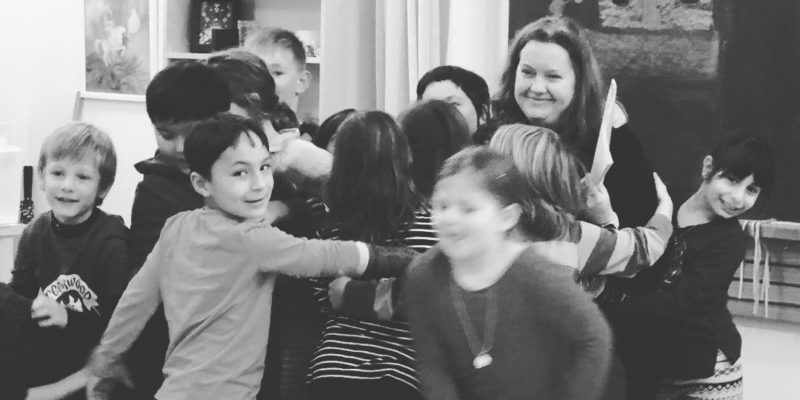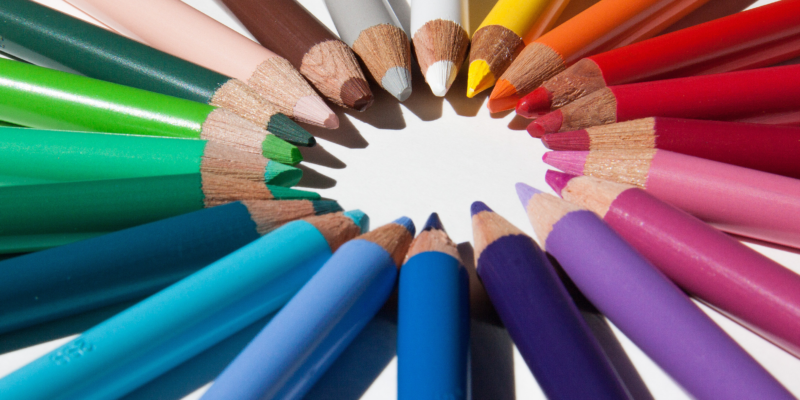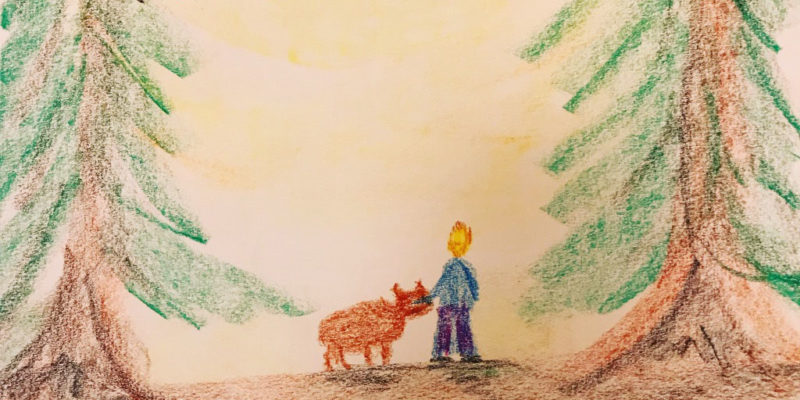We start our first language arts block on Monday, so this weekend I took some time to really solidify what we’re going to do during each of our language arts blocks and I’m feeling really good about the plan.
By the way, if you’re looking at teaching 1st grade language arts anytime soon, you might want to check out my first grade curriculum guides. Since writing this post I’ve put it all together in a handy PDF download — lesson plans, drawings, circle content, everything!
After years in the middle school where you often get just one short three-week block for a subject, five(!) language arts blocks in the year feels positively luxurious! (Not all of them are 4-week blocks, but many of them are.) Here’s what we’ll focus on in each block.
- Block #1 (October) — Fairy Tales: The Consonants
- Block #2 (December) — Amahl and the Night Visitors: The Vowels
- Block #3 (January) — Fairy Tales: Sight Words Emphasis, Long and Short Vowels
- Block #4 (March) — Nature Stories: Phonics Emphasis, Blends, Lower Case
- Block #5 (June) — Nature Stories: Writing Our Own Book
For this first block, the big question I asked myself and all of my various resources was what order the consonants should be presented in. Much of first grade seems to be pretty straightforward and traditional, without a lot of variation from teacher to teacher, so I was surprised to not find a prescribed order of presentation. Instead, I found lots of different opinions and a handful of things to think about when determining which consonants to present first.
The Evolutionary Sequence
I do not have eurythmy training, so I can’t speak with much authority on this topic, but Rudolf Steiner gave the students in the first eurythmy training a sequence of sounds that form what is referred to as “the evolutionary sequence.” These consonants reflect the development of the human being’s speech faculty and some teachers follow this sequence when introducing the letters in first grade. The evolutionary sequence is as follows: B, M, D, N, R, L, G, ch, F, S, H, T — then K, P and V.
The other consonants are added as the teacher sees fit. Because this sequence was created by Rudolf Steiner, it was not imagined with the English language in mind. When I think of babies and their process of making sound, this sequence makes some sense to me, so there may be some universal aspect to the evolutionary sequence. I do seem to recall my babies making B, D and M sounds first, but I’m not sure that this transfers to the English speaking child’s development of reading, which is what we’re concerned with in first grade.
I think knowing and understanding the evolutionary sequence is worth the effort, but using this order as a prescription for introducing the consonants is definitely not recommended. I think sometimes teachers learn about this sequence and believe that there is some esoteric significance to introducing the consonants in this order and then decide to follow it without really understanding why. I’m all about knowing and understanding why you do things.
Incidentally, several of my resources specifically mentioned not to follow the evolutionary sequence in favor of another system that would make more sense for the children.
Reliability
Reliability is a measure of how consistently a particular consonant makes its sound. The most reliable letters always make the same sound. The least reliable letters change their sounds frequently. It makes a lot of sense to me that my students will have an easier time learning and using the letters and sounds they learn if we start with the most reliable consonants.
According to this website, here’s a breakdown of the most reliable consonants.
Very reliable: M, R, V, Q
Generally reliable: B, H, K, L, P
Reliable: D, F, J, N, Z
Unreliable: G, C, W, Y
Very unreliable: S, T, X
I was really glad to come upon this information because without it I probably would have brought T and S very early in the block, because of the other factors I’m taking into consideration.
Frequency
Resources handed down to me by my colleagues recommended using frequency to determine the order of presentation. Teach the children the letters they are going to encounter most first. When it comes to frequency, though, there are different types of words to consider. You want to present the letters that are most common in single letter sounds (double letter sounds use the letter H so much, it confuses things a bit.) Here are the consonants in order of frequency.
S, T, R, N, C, L, M, P, B, F, D, G, H, V, K, J, Z, W, Y, Q, X
Clarity of Image
Now, of course I want to choose stories and images that relate very strongly to the letters, but I recognize that it is difficult to find some of the letters in images. I want to make sure I start with stories in which the letter is very clear. By the end of the block the students will be in the habit of finding the letters in the stories, so it’s okay if they’re not so closely related — they may even enjoy looking for the letter like it’s a puzzle.
Also, I learned from Kelly Morrow, an instructor at the Art of Teaching conference, that the sound is most pure and clearly understood in consonant-vowel-consonant words. For this reason, fish would be a much better word image choice than frog. That fr– beginning just makes the f sound less clear. I thought about this as I chose images in stories.
Letters That Go Together
My goal is to introduce all of the consonants in this first block. It’s a bit ambitious — many teachers do it in two blocks, but I want to make sure I have time for lower case letters at the end of the year and I think my group is ready. As always, I’ll observe and adjust along the way as necessary. In order to keep this pace, though, I will need to tell a few stories that introduce multiple letters. I started out thinking that each week there would be one double-letter story, while the rest of the stories that week would introduce one letter.
So, here’s how I put all of this information together.
First, I decided to not tie myself to the evolutionary sequence, but keep it handy to reference if I was conflicted about something.
Second, I made a list of the stories I knew that could work for multiple letters. I used a list of fairy tales shared with me by Kelly Morrow at the Art of Teaching conference, and another shared by a fellow first grade teacher.
- Simeli Mountain (C — cavern, M — mountain)
- Finist the Falcon (F — feather, L — ledge)
- Sylvain and Jocosa (V — vine, R — river)
- Jesper Who Herded Hares (P — proud prince, H — hare jumping hedge)
- Hansel & Gretel (H — house, D — door)
- King Thrushbeard (K — king, Q — queen, J — jester)
- Fisherman and His Wife (Y — yard, Z — zig-zag lightning, W — wave)
Then, I made a chart that ranked the letters according to their reliability and frequency. If I was a math teacher I would have done this on an X and Y axis :-).

So, the letters on the far left were good choices for the first week, the ones on the right would be for the last week. Having this figured out meant that I could start placing the stories, starting with the multi-letter stories. Here’s the final plan I came up with.
Again, this is ambitious and I may end up reducing greatly if it seems too much for my students. If I do decide to reduce, I’m thinking I’ll start by reducing the amount of bookwork (recommendations are to create a drawing and a letter page for each letter, but I think a drawing for each story, including each letter, is sufficient.)

As mentioned, I’m grateful to Kelly Morrow and other teacher friends for sharing this list of stories.
Week #1
- B (bear) — Snow White & Rose Red
- M (mountain) — Simeli Mountain
- C (cavern) — Simeli Mountain (C is not a great letter to bring so early but it goes so well with M in Simeli Mountain)
- L (leg) — Tall, Broad and Long
- R (hair) — Rapunzel
Week #2
- D (door) — Vasilisa or Hansel & Gretel
- H (house) — Vasilisa or Hansel & Gretel
- P (pole picking plums) — Prunella
- N (needle with thread) — Spindle, Shuttle, Needle
- G (goose) — Golden Goose
Week #3 (short week)
- K, Q, J (king, queen, jester) — King Thrushbeard
- F, T (fire, tree) — The Twelve Months
Week #4
- V (vine) — Laughing Eye & Weeping Eye or Sylvain & Jocosa
- S (swan or sister) — The Six Swans (Swan isn’t the best image choice because of the blend, but I just love this story! That’s why I’ll consider adding sister.)
- X (hair in water) — Nixie in the Mill Pond
- W, Y, Z (wave, yard, zigzag) — The Fisherman’s Wife (another story I just love! Read about the shadow puppet play my 7th graders did a couple years ago.)
Since sorting this out, I’ve been busy reading stories and just loving them. After our form drawing block, which was full of simple little stories, I’m so glad to have some good juicy content to sink our teeth into!
I feel good about most of these choices but there are a few exceptions.
- First of all, you can see that I’m still on the fence about a couple of them. I’ll read and contemplate before deciding.
- I really like the story Finist the Falcon, which was recommended for F (feather) and L (ledge). I love feather, but I don’t love ledge, so I don’t think it would work for L alone. But I also really love The Twelve Months, which is what I settled on for F. I don’t love Tall, Broad and Long. If you’ve got a better suggestion for L, I’d love to hear it.
- I like Prunella, but the image isn’t great. Suggestions for P?
Have you taught first grade? What stories did you tell for the consonants?
Incidentally, I’ve got a fairly international group of students, so I’m pleased that I’ve got some Russian and Greek stories on the list.
Tomorrow I’m going to start working on the drawings, so keep an eye on my social media — Facebook and Instagram. In the past I’ve let the review activities and drawings unfold naturally from the new content, but this block is different in that I know which aspects of the stories (the letters) I want our drawings to emphasize.
I’m excited to start bringing this content on Monday!




WOW. Thank you for writing this up with so much depth! As a former public-school middle-school English teacher, I knew teaching reading and writing for first-timers was “harder than it looked,” but now I think it’s even harder than that! This is so incredibly thoughtful. I am SO impressed.
I’m now attempting Waldorf-style homeschool, still at the preschool level–totally overwhelmed by the amount of resources available but will definitely be checking out everything you have to offer! This is probably not a fair question to leave in a blog comment (too big), but if you felt like writing about it, I would really value your opinion! 🙂 I really respect the Waldorf emphasis on literature over learning to read easy things right away–but my nearly-5-year-old is really interested in text–she asks me to write her name and copies it over, she asks me what letters are. Without needing to rush it at all … would it be “bad” to let her start her letters early?
Holy cow! You’re amazing! ❤️
Hello recently came across your website and podcasts! Thank you for your time to share all this resource. Very helpful and I am thankful!